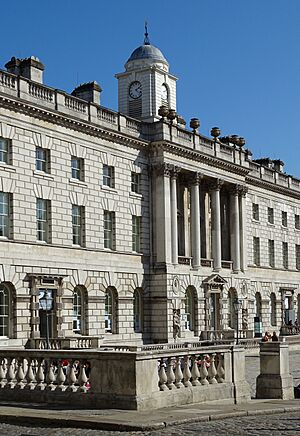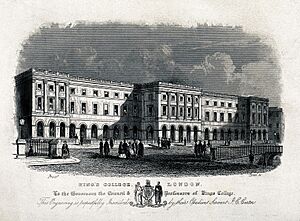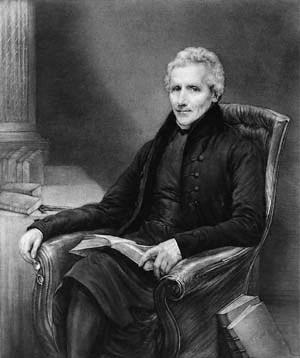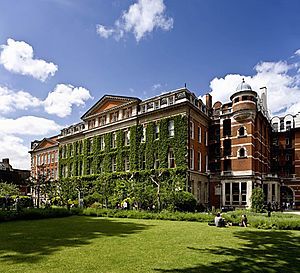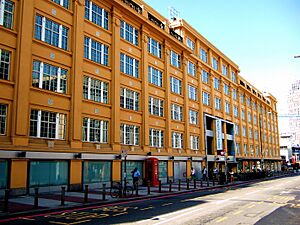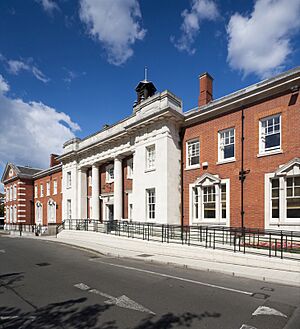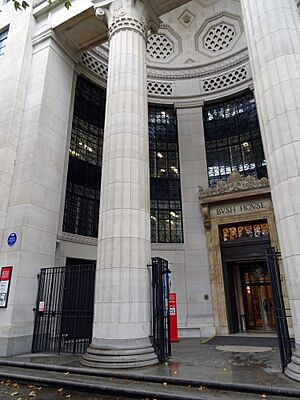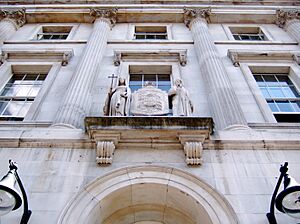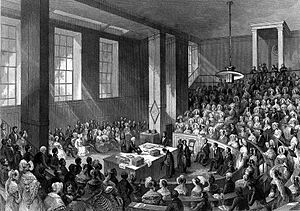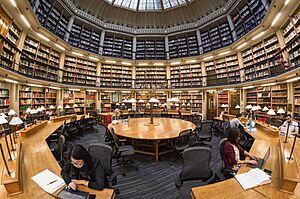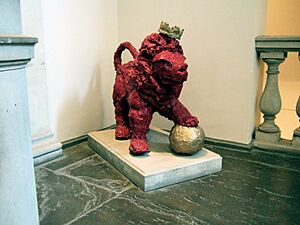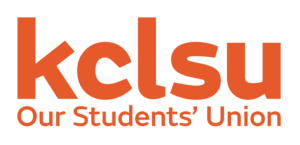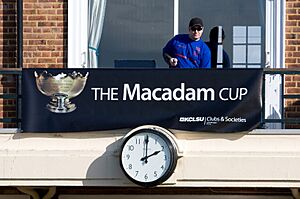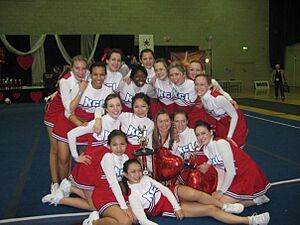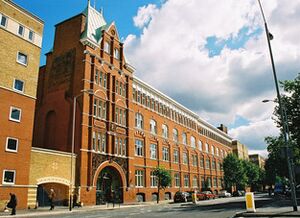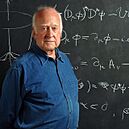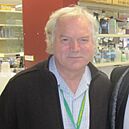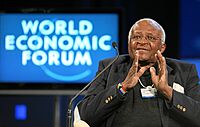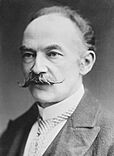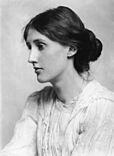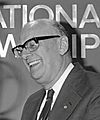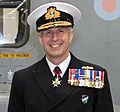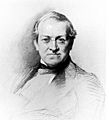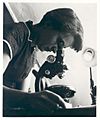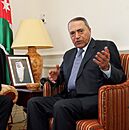King's College London facts for kids
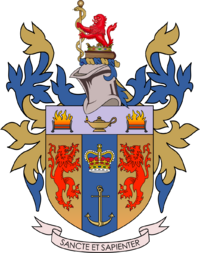
Coat of arms
|
||||||||||||
| Latin: Collegium Regale Londiniense | ||||||||||||
| Motto | Latin: Sancte et Sapienter | |||||||||||
|---|---|---|---|---|---|---|---|---|---|---|---|---|
|
Motto in English
|
With Holiness and Wisdom | |||||||||||
| Type | Public research university | |||||||||||
| Established | 1829 (earliest recorded teaching in medical school 1561) | |||||||||||
| Endowment | £301.0 million (2023) | |||||||||||
| Budget | £1.230 billion (2022/23) | |||||||||||
| Chair | Lord Geidt | |||||||||||
| Visitor | Justin Welby (as Archbishop of Canterbury ex officio) |
|||||||||||
| Chancellor | The Princess Royal (as Chancellor of the University of London) |
|||||||||||
| Vice-Chancellor and President | Shitij Kapur | |||||||||||
|
Academic staff
|
5,715 (2021/22) | |||||||||||
|
Administrative staff
|
4,240 (2021/22) | |||||||||||
| Students | 41,490 (2021/22) | |||||||||||
| Undergraduates | 23,225 (2021/22) | |||||||||||
| Postgraduates | 18,270 (2021/22) | |||||||||||
| Location |
London
,
England
|
|||||||||||
| Campus | Urban | |||||||||||
| Patron | HM The King | |||||||||||
| Colours |
|
|||||||||||
| Affiliations |
|
|||||||||||
| Mascot | Reggie the Lion | |||||||||||
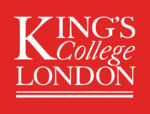 |
||||||||||||
King's College London (often called King's or KCL) is a public research university in London, England. It was started by a special royal document in 1829. King George IV and the Duke of Wellington supported its creation.
In 1836, King's became one of the first colleges to form the University of London. It is one of the oldest universities in England. Over time, King's grew by joining with other colleges. These included Queen Elizabeth College and Chelsea College in 1985. It also merged with the Institute of Psychiatry in 1997. In 1998, it joined with medical and nursing schools. This included the world's first nursing school, founded by Florence Nightingale.
King's has five main locations in London. Its historic Strand Campus is in central London. Three other campuses (Guy's, St Thomas' and Waterloo) are near the River Thames. There is also a campus in Denmark Hill in south London. King's also has places for military education in Oxfordshire. Its information center is in Cornwall.
The university has nine main academic areas called faculties. These are divided into many departments and research groups. King's has a large income, with a lot of money from research. It has the biggest financial gift (endowment) of any university in London. King's is also one of the largest universities in the UK by student numbers. Over 69,000 students apply each year.
King's is part of important academic groups. These include the Russell Group, which is for leading research universities. It is also a founding member of King's Health Partners. This is a special center for health sciences. King's is known as part of the "golden triangle" of top universities. This group includes Oxford, Cambridge, and London universities. King's has always had royal support. King Charles III became its patron in 2024.
Many famous people have studied or worked at King's. These include 14 Nobel laureates. People from King's helped discover the structure of DNA. They also made breakthroughs in medicine and technology. Alumni include leaders of countries and governments. They also include Oscar, Grammy, and Emmy winners.
Contents
- History of King's College London
- King's College London Campuses
- How King's College London is Run
- Leadership
- Academic Areas and Departments
- Faculty of Arts and Humanities
- Faculty of Dentistry, Oral & Craniofacial Sciences
- Faculty of Life Sciences and Medicine
- Institute of Psychiatry, Psychology and Neuroscience
- The Dickson Poon School of Law
- Faculty of Natural, Mathematical & Engineering Sciences
- Florence Nightingale Faculty of Nursing and Midwifery
- Faculty of Social Science and Public Policy
- King's Business School
- Money and Funding
- University Symbols (Coat of Arms)
- Partnerships and Connections
- Academic Life at King's
- Student Life at King's
- Famous People from King's
- Images for kids
- See also
History of King's College London
How King's College London Started
King's College was named after King George IV. It was founded in 1829. However, its medical school roots go back to 1561. King's was created because of a disagreement. Another university, "London University" (now University College, London), started in 1826. This university was open to everyone, no matter their religion. It was called "the godless college."
At that time, universities like Oxford and Cambridge were only for wealthy Anglicans. Many people felt a new, secular university was needed. But others disagreed with this idea. King's College was created to offer education with strong religious values. It supported the traditional Church of England.
King's was one of many new institutions. These appeared in the 1800s due to the Industrial Revolution. Because of its founding, King's has always had royal support. The Archbishop of Canterbury is also a special visitor. Important government figures were also governors in the 1800s.
The Famous Duel of 1829
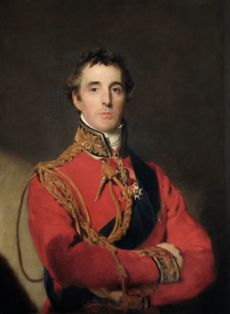
In 1829, Arthur Wellesley, 1st Duke of Wellington, was the Prime Minister. He supported King's College London, which was Anglican. But he also supported a law to give Catholics more rights. This upset some people, like the Earl of Winchilsea.
Winchilsea wanted King's to be only for Anglicans. He withdrew his support for the college. He also wrote a letter accusing Wellington of bad intentions. Wellington was very angry. He challenged Winchilsea to a duel.
The duel happened on March 21, 1829, in Battersea Fields. Winchilsea chose not to fire his pistol. Wellington aimed and fired his shot wide. Accounts differ on whether he missed on purpose. After this, Winchilsea apologized. King's College still celebrates "Duel Day" every year. They even re-enact the duel!
King's College in the 1800s
King's opened in October 1831. William Otter was its first leader and a teacher. The Archbishop of Canterbury led the opening ceremony. Even though it was meant to be Anglican-only, other religions could attend. Teachers had to be Anglican, but students did not. However, going to chapel was required.
King's had a senior part and a junior part. The junior part was called King's College School. It started in the basement of the Strand Campus. It grew quickly and moved to Wimbledon in 1897. Today, it is a separate school.
In the senior part, students could study different subjects. These included religion, languages, math, and history. There was also a medical course. In 1833, King's started giving its own qualification, the Associate of King's College (AKC). This course, which covers ethics and religion, is still offered today.
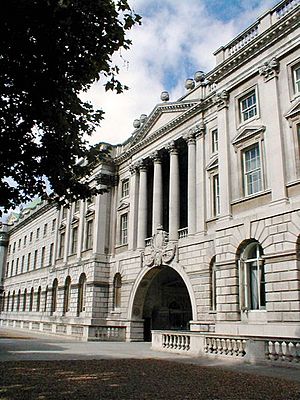
The building along the river was finished in 1835. Student numbers in the senior part grew slowly at first. In 1835, the government decided to create a board to give out degrees. Both "London University" and King's became part of this. This became the University of London in 1836. The first University of London degrees were given to King's students in 1839.
In 1840, King's opened its own hospital. It was in a poor area with many diseases. The hospital later moved to Denmark Hill in 1913. A famous doctor, Joseph Lister, joined in 1877. He introduced antiseptic surgery. This made the hospital famous worldwide.
King's also started a Military Department in 1845. This was to train officers for the Army. In 1846, a Theological Department was created for Anglican priests. In 1855, King's was a pioneer in offering evening classes in London.
In 1882, a new law changed King's. It stopped being a "for-profit" college. Its name became "King's College London." The law also allowed women to be educated at King's. The Ladies' Department opened in 1885. It later became King's College Women's Department in 1902.
King's College in the 1900s
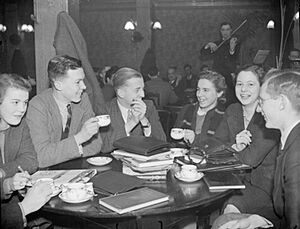
In 1903, a new law removed most religious tests for staff. In 1910, King's (except for the Theological department) joined the University of London. It lost its legal independence for a while.
During World War I, women were allowed into the medical school for the first time. After the war, many students joined. This made the college very crowded.
In World War II, King's buildings were used by fire services. Parts of the Strand building were damaged by bombs. After the war, new laboratories were built.
One of the most famous scientific discoveries at King's happened in 1953. Maurice Wilkins and Rosalind Franklin made key contributions to finding the double helix structure of DNA. They worked with other scientists at King's.
King's started major rebuilding in 1966. In 1980, King's became legally independent again. In 1993, it could get government funding directly. It also gained the right to give out its own degrees. This made King's act more like a university on its own.
King's College London joined with several other institutions in the late 1900s. In 1983, the King's College School of Medicine and Dentistry rejoined King's. In 1985, it merged with Queen Elizabeth College and Chelsea College. The Institute of Psychiatry joined in 1997. In 1998, two more medical and dental schools merged with King's. Also in 1998, Florence Nightingale's nursing school joined King's. The same year, King's bought a historic building. It turned it into the Maughan Library, which opened in 2002.
King's College in the 2000s

In 2006, King's College London was allowed to give its own degrees. Before, degrees were given by the University of London. From 2007, all new students got degrees from King's itself. The first King's degrees were given in 2008.
In 2011, King's became a founding partner of the Francis Crick Institute. This is a big medical research project. The Chemistry department, which had closed in 2003, reopened in 2011. In 2012, Queen Elizabeth officially opened the Somerset House East Wing.
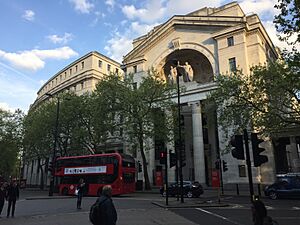
In 2014, King's College London opened a special math school for older students. In 2015, King's got a long-term lease for the historic Bush House. It started using Bush House for teaching in 2016.
King's College London Campuses
Strand Campus
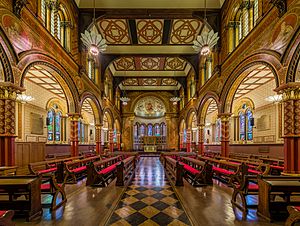
The Strand Campus is where King's College London first started. It is on the Strand in central London. It is also next to the River Thames. The main part of the campus includes the King's Building from 1831. The King's College London Chapel was redesigned in 1864. King's has also bought other nearby buildings. The Macadam Building houses the student union.
The Strand Campus is home to the arts and science faculties. These include Arts & Humanities, Law, Business, Social Science, and Natural, Mathematical & Engineering Sciences. The main office for the university's leader is also here.
Since 2010, the campus has grown. It now includes the East Wing of Somerset House. It also has the Virginia Woolf Building. In 2015, King's got a 50-year lease for the historic Bush House building. It started using Bush House in 2016.
The closest train stations are Temple, Charing Cross, and Covent Garden.
Guy's Campus
Guy's Campus is near London Bridge and the Shard. It is on the South Bank of the Thames. This campus is home to the Faculty of Life Sciences & Medicine. It also has the Dental Institute.
The campus is named after Thomas Guy. He founded Guy's Hospital in 1726. Important buildings include the Henriette Raphael building and the Hodgkin building. The Gordon Museum of Pathology is also here. The student union has many facilities on this campus. These include a cafe and a bar.
The closest train stations are London Bridge and Borough.
Waterloo Campus
The Waterloo Campus is across Waterloo Bridge from the Strand Campus. It is near the Southbank Centre. It includes the James Clerk Maxwell Building and the Franklin–Wilkins Building.
The Franklin-Wilkins Building was built between 1912 and 1915. It was first a government office. During World War I, it became a military hospital. King's bought the building in the 1980s. It was renovated in 2000. The building is named after Rosalind Franklin and Maurice Wilkins. They helped discover the structure of DNA.
Today, this building houses the School of Biomedical Sciences. It also has the School of Education, Communication and Society. The London Dental Education Centre is here too. The James Clerk Maxwell Building houses the Florence Nightingale Faculty of Nursing, Midwifery & Palliative Care. It is named after the physicist James Clerk Maxwell.
The closest train station is Waterloo.
St Thomas's Campus
The St Thomas' Campus is in Lambeth. It faces the Houses of Parliament across the Thames. This campus has parts of the School of Medicine and the Dental Institute. The Florence Nightingale Museum is also located here. This museum honors Florence Nightingale. She founded the nursing school that is now part of King's. St Thomas' Hospital joined King's in 1998.
The closest train station is Westminster.
Denmark Hill Campus
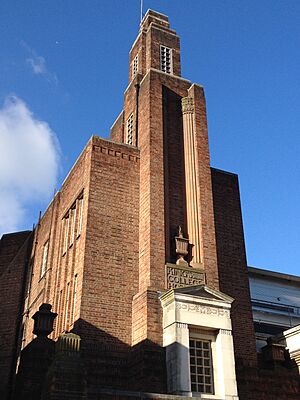
Denmark Hill Campus is in south London. It is the only campus not on the River Thames. This campus includes King's College Hospital and the Maudsley Hospital. It also has the Institute of Psychiatry, Psychology and Neuroscience (IoPPN). Parts of the Dental Institute and School of Medicine are here. There is also a large student hall of residence.
The Maurice Wohl Clinical Neuroscience Institute opened here in 2015. It is named after a generous supporter of King's.
The closest train station is Denmark Hill.
Redevelopment and New Buildings
King's College London is currently improving its campuses. It is spending £1 billion on new and renovated buildings. Many projects have been finished. These include a £35 million renovation of the Maughan Library in 2002. There was also a £40 million renovation at the Strand Campus.
The Strand Campus redevelopment won an award in 2007. It was recognized for using sustainable construction. The Maughan Library also won an award in 2003 for its renovation.
Future plans include a £45 million project for the Maurice Wohl Clinical Neuroscience Institute. There are also plans to improve teaching spaces. A £20 million redevelopment of the Strand Campus Quad is planned. This will add more teaching and student areas.
King's also acquired a long-term lease for the Aldwych Quarter. This includes Bush House. This will greatly expand the original Strand Campus.
How King's College London is Run
Leadership
The main leader of King's College London is called the President and Principal. Currently, this is Shitij Kapur. He started in June 2021. The President is in charge of making sure the university runs well.
The university is governed by a council. This council has 21 members. It includes the student union president and staff members. It also has members from outside the university. Sir Christopher Geidt is the current Chairman of the Council.
The Dean of King's College London is Reverend Dr Ellen Clark-King. The Dean is usually an ordained minister. This shows King's connection to the Church of England. The Dean helps with the spiritual well-being of students and staff. The Dean also oversees the Associateship of King's College program.
The Archbishop of Canterbury is a special visitor to King's. This is because King's was founded with Anglican traditions. The current visitor is The Most Reverend Justin Welby.
Academic Areas and Departments
In the 1800s, King's had five main departments. These included Theology, General Literature and Science, Applied Sciences, Medical, and Military.
Today, King's has nine main academic areas called faculties. These are divided into schools, departments, and research groups. King's Business School is the newest addition. It opened in 2017.
Faculty of Arts and Humanities
This faculty is on the Strand Campus in central London. It is close to many famous cultural places. These include the British Museum and the National Portrait Gallery. In 2024, King's Arts & Humanities was ranked among the top 20 worldwide.
The Faculty of Arts and Humanities was formed in 1989. It brought together Arts, Music, and Theology. It is strong in traditional subjects like Philosophy, Classics, and History. It also excels in newer fields like Digital Humanities and Film.
In 2023, the faculty started two new Institutes. These are the Digital Futures Institute and the Global Cultures Institute. They focus on new education and research.
Faculty of Dentistry, Oral & Craniofacial Sciences
This faculty is King's dental school. It focuses on understanding diseases and improving health. It is the successor to several older dental schools. These include Guy's Hospital Dental School.
Dental surgery lectures started at Guy's Hospital in 1799. Guy's Hospital Dental School was officially started in 1888. It became part of the University of London in 1901. Over the years, different dental schools merged to form this faculty.
Faculty of Life Sciences and Medicine
This faculty was created in 2014. It combined the School of Medicine with the School of Biomedical Sciences.
It has two main schools for education. The GKT School of Medical Education trains medical students. The School of Bioscience Education trains students in biomedical sciences. The faculty is also divided into seven other schools. These cover areas like Cancer, Cardiovascular Medicine, and Immunology.
Institute of Psychiatry, Psychology and Neuroscience
The Institute of Psychiatry, Psychology and Neuroscience (IoPPN) is a research center. It studies what causes mental illness and brain diseases. It also looks for new treatments. It is the largest center for research and education in psychiatry in Europe. It started in 1924 and joined King's in 1997.
The Dickson Poon School of Law
The Dickson Poon School of Law is King's law school. Law has been taught at King's since 1831. The School of Law was officially formed in 1991.
The school has many research centers. These focus on areas like European Law, Medical Law, and Technology Ethics.
Faculty of Natural, Mathematical & Engineering Sciences
This faculty was created in 2010. It was renamed in 2021 to include engineering again. It offers education and research in chemistry, computer science, physics, math, and engineering. Many Nobel laureates have been part of this faculty. Its experimental Physics teaching is the oldest in England.
Chemistry has been taught at King's since 1829. The Chemistry Department closed in 2003 but reopened in 2011. The new department covers traditional chemistry and other sciences.
The Department of Engineering started in 1838. It is one of the oldest engineering schools in the UK. The King's College Engineering Society is the oldest of its kind. The engineering division closed in 2013 but was brought back in 2019.
Florence Nightingale Faculty of Nursing and Midwifery

This faculty trains nurses and midwives. It also does nursing research. It was started by Florence Nightingale in 1860. It is the first nursing school in the world. It has always been connected to a hospital and medical school.
The Nightingale Training School merged with other nursing schools in 1996. All staff and students became part of King's.
Faculty of Social Science and Public Policy
This faculty was created in 2001. It is one of the largest centers for policy research in the UK. It is divided into four schools:
- School of Politics & Economics
- School of Education, Communication and Society
- School of Global Affairs
- School of Security Studies (including War Studies)
The Department of War Studies is unique in the UK. It has research facilities like the Liddell Hart Centre for Military Archives.
King's Business School
King's Business School opened in August 2017. It is based in Bush House. It was formed from the School of Management and Business. In 2021, it was ranked second in the UK for Business and Management studies.
The business school has four research centers. These focus on digital analytics, finance, and the future of work.
King's Business School offers degrees in economics, management, and finance. Its courses focus on modern business theory. They also include topics like psychology and law. Many international students attend these courses.
Money and Funding
King's College London has a large income. In 2019, its total income was over £900 million. A big part of this comes from student fees and research grants. King's has the fourth largest financial gift (endowment) among UK universities. It is the largest in London.
King's has received many grants from the Bill & Melinda Gates Foundation. These support research in global health.
University Symbols (Coat of Arms)
The coat of arms on King's College London's founding document is from King George IV. It shows the royal coat of arms. The symbols on the shield represent King's motto: Sancte et Sapienter (With Holiness and Wisdom).
Over the years, different versions of the coat of arms were used. The current one was created after mergers in 1985. It includes parts of the symbols from the colleges that joined King's.
Medical School Symbols
The medical schools at King's still use symbols from their original hospitals. For example, Guy's Medical School uses Guy's Hospital's coat of arms.
When the medical schools merged in 1998, they combined their symbols. The shields of Guy's and St Thomas' hospitals are used with King's shield. You can see these on publications and graduation materials.
Partnerships and Connections
King's College London is a member of the University of London. It was one of its two founding colleges. In 1998, King's joined the Russell Group. This group includes 24 top public research universities. King's is also part of other European and Commonwealth university networks.
King's is considered part of the "golden triangle." This group includes top research universities in Oxford, Cambridge, and London.
King's is a founding member of King's Health Partners. This is a large academic health science center in Europe. It also helped create the Francis Crick Institute. This is a major biomedical research center. King's also works with Imperial College and University College London in MedCity. This group promotes health and life sciences in London.
In 2016, King's joined the PLuS Alliance. This is an international group with universities in Arizona and New South Wales. They work together on global challenges. King's is also a founding partner of FutureLearn. This is a platform for online courses.
King's offers joint degrees with many other universities. These include Columbia University and the University of Hong Kong. It also partners with cultural institutions like the Royal Academy of Music and the British Museum.
In Math, King's works with Imperial College London and University College London. They run the London School of Geometry and Number Theory. This offers PhD projects in math. They also work together on Nanotechnology at the London Centre for Nanotechnology.
King's is part of the SES research alliance. This group includes other top UK universities. It is also a member of the Thomas Young Centre. This group studies materials using theory and simulation.
Academic Life at King's
Student Admissions
|
| Domicile and Ethnicity | Total | ||
|---|---|---|---|
| British White | 28% |
|
|
| British Ethnic Minorities | 31% |
|
|
| International EU | 9% |
|
|
| International Non-EU | 32% |
|
|
| Undergraduate Widening Participation Indicators | |||
| Female | 64% |
|
|
| Private School | 17% |
|
|
| Low Participation Areas | 5% |
|
|
King's has high entry requirements for students. In 2018, it had the 13th highest average entry scores in the UK. In 2022, only about 39% of applicants received an offer. This was the 8th lowest offer rate in the country.
About 24% of King's undergraduate students come from private schools. In 2016–17, most students were from the UK. About 62% of students were female.
In 2018, King's received over 39,000 applications. Only about 4,700 students were accepted. This means an acceptance rate of about 12%. The School of Medicine is very competitive. Only about 2% of applicants received an offer.
Teaching and Learning
King's academic year starts in late September and ends in early June. Different departments have different term structures. For example, the Math School has three terms. The Arts & Humanities faculty uses two semesters.
Graduation Ceremonies

Graduation ceremonies happen in January and in June or July. Most ceremonies are held at the Southbank Centre. This is next to the Waterloo Campus.
Students from the GKT School of Medical Education and Dental Institute graduate from Southwark Cathedral. This is near Guy's Campus.
Since 2008, King's graduates wear special gowns. These were designed by Vivienne Westwood. This is because King's started giving its own degrees in 2006.
Research at King's
King's College London is a major research university. In 2013/14, its research income was over £171 million. This money comes from charities, research councils, and governments.
In 2021, King's was ranked 9th in the UK for research quality. It was ranked 6th for its research power. This means it has many high-quality researchers. King's research was described as "arguably the biggest winner" in the 2014 assessment.
Medical Education and Research
King's says it is the largest center for healthcare education in Europe. The King's College London School of Medicine has over 2,000 students. It works with four main teaching hospitals. These include Guy's Hospital and St Thomas' Hospital. It is ranked the 8th best university in the world for Medicine. The Dental Institute is the largest dental school in Europe. The Florence Nightingale School of Nursing & Midwifery is the world's oldest nursing school.
King's is a big center for biomedical research. It is a founding member of King's Health Partners. This is one of the largest academic health science centers in Europe. It also has six Medical Research Council centers.
The Drug Control Centre at King's was started in 1978. It is the only anti-doping lab in the UK approved by WADA. It tests UK athletes for doping. It was the anti-doping facility for the London 2012 Olympic and Paralympic Games.
Libraries at King's
King's has many libraries across its campuses. They hold over one million printed books. They also have thousands of journals and online resources.
The Maughan Library
The Maughan Library is King's largest library. It is in a beautiful 19th-century gothic building. This building used to be the Public Record Office. It is on Chancery Lane at the Strand Campus. It holds books for Arts & Humanities, Law, Sciences, and Social Science. It also has special collections and rare books.
Inside, there is an octagonal Round Reading Room. It was inspired by the British Museum's reading room. The former Rolls Chapel is also there. It has stained glass windows and a mosaic floor.
Other Libraries
- Foyle Special Collections Library: This library is also on Chancery Lane. It has 180,000 printed works. It also has maps, slides, and sound recordings. The collections cover many subjects. They include European military history and Jewish theology.
- Tony Arnold Library: Also on Chancery Lane, this library has over 3,000 law books. It is named after Tony Arnold, a long-serving Secretary of the Institute of Taxation.
- Archives Reading Room: This room on Chancery Lane holds records of King's College. It also has papers from institutions that merged with King's. It includes research papers of famous staff like Maurice Wilkins.
- Franklin-Wilkins Library: This library is at the Waterloo Campus. It has many books on management and education. It also covers biomedical, health, and life sciences.
- Wills Library and Keats Room: Located at Guy's Campus, this was the main library for Guy's Hospital Medical School. It was a gift in 1903. The Keats Room is named after King's alumnus John Keats. He was a medical student at Guy's Hospital.
- New Hunt's House Library: Also at Guy's Campus, this library covers biomedical science. It includes anatomy, biochemistry, and genetics. It also has resources for medicine and dentistry.
- St Thomas' House Library: This library is at St Thomas' Campus. It focuses on medical sciences and clinical medicine. It is strong in dermatology and pediatrics.
- Institute of Psychiatry Library: This is the largest psychiatric library in Western Europe. It has many journals and books on psychiatry, psychology, and neuroscience.
- Weston Education Centre Library: Located at the Denmark Hill Campus, this library focuses on gastroenterology and liver disease. It also covers diabetes and the history of medicine.
King's students can also use the Senate House Library. This is the main library for the University of London.
Museums and Collections
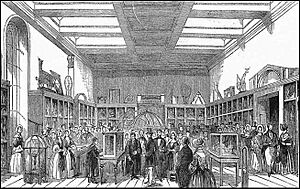
King's has two museums: the Gordon Museum of Pathology and the Museum of Life Sciences. The Gordon Museum opened in 1905 at Guy's Campus. It is the largest medical museum in the UK. It has about 8,000 medical specimens and artifacts. The Museum of Life Sciences opened in 2009. It has historic biological and pharmaceutical collections.
The King George III Museum was at King's between 1843 and 1927. It held scientific instruments. Many of its collections are now at the Science Museum.
The Anatomy Museum was in the King's Building at the Strand Campus. It had medical casts and animal skins. The Anatomy Theatre next door was used for dissections. It is now a space for teaching and performances.
The Foyle Special Collections Library has many unique collections. These range from the 15th century to today. They cover subjects from human anatomy to Greek poetry. The Foreign and Commonwealth Office Historical Collection is also here. It has over 80,000 items. The Medical Collection includes historical books from medical schools. The Rare Books Collection has 12,000 printed books. These include first editions of Charles Dickens' novels.
King's College London Archives holds the university's records. These include records since 1828. The Liddell Hart Centre for Military Archives holds papers of British defense leaders.
Science Gallery London is set to open in 2018 at Guy's Campus. It is a public science center where art and science meet. It will have exhibition galleries and a cafe. It will not have a permanent collection.
Rankings and Reputation
| National rankings | |
|---|---|
| Complete (2021) | 24 |
| Guardian (2021) | 23 |
| Times / Sunday Times (2021) | 27 |
| Global rankings | |
| ARWU (2020) | 59 |
| CWTS Leiden (2020) | 39 |
| QS (2021) |
40= |
| THE (2021) | 38= |
| British Government assessment | |
| Teaching Excellence Framework | Silver |
King's is highly ranked among global universities. In 2021, it was ranked 31st by QS World University Rankings. It was 35th by Times Higher Education and 34th by U.S. News & World Report.
King's is in the top seven UK universities in all six major global rankings.
According to the 2021 Complete University Guide, 9 of King's subjects are in the top 10 nationally. These include Business & Management Studies (2nd) and Law (4th). The Guardian University Guide 2021 ranks King's in the top ten for 6 subjects. These include Psychology (2nd) and Politics (5th). Times Higher Education ranks King's in the top 20 worldwide for Psychology and Clinical Health.
In 2010, Sunday Times named King's the "University of the Year 2010–11." King's is also highly rated by employers. In 2015, it was chosen as the 5th best UK university by major British employers.
King's graduates also earn good salaries. In 2014, King's ranked 5th for highest graduate starting salaries. A study showed that King's graduates were among the highest earners 10 years after graduation.
Associateship of King's College (AKC)
The Associateship of King's College (AKC) is King's oldest award. It dates back to 1829. It was created to combine "sound religion and useful learning."
Today, the AKC is an optional program. It offers lectures on religious, philosophical, and ethical issues. Students can take this course alongside their main degree. Graduates who complete it can use the letters "AKC" after their name.
Fellowship of King's College (FKC)
The Fellowship of King's College (FKC) is the highest award King's can give. It recognizes great service to King's. It also honors people who have achieved great things.
The first FKC was John Allen, a former chaplain. The first women fellows were chosen in 1904.
Student Life at King's
Students' Union
The King's College London Students' Union (KCLSU) was founded in 1873. It is one of the oldest student unions in England. The union offers many activities and services. These include over 50 sports clubs. It also has over 200 activity groups. There are volunteering opportunities, bars, and a gym.
Sir Ivison Macadam, a former president of KCLSU, became the first president of the National Union of Students.
"Reggie the Lion" is the official mascot of the students' union. There are four Reggie mascots. The original is displayed in Bush House. A papier-mâché Reggie is outside the Great Hall. Another Reggie guards a common room. A small silver Reggie is used during graduation ceremonies.
KCLSU runs several student social spaces. These include The Shed cafe and Guy's Bar.
Student Media
KCLSU Student Media won Student Media of the Year in 2014. It was also among the top three student media outlets in the country.
Roar News is a student newspaper. It is owned by KCLSU but is independent. Its website is read by many people worldwide. In 2014, it won several national awards.
KCL Radio is the student radio station. It started in 2009. In 2013, it relaunched as a live station. It broadcasts news, music, and debates.
Other student media groups include KingsTV (student television) and KCLSU PhotoSoc (photography society).
Sports at King's
King's has over 60 sports clubs. Many compete in university leagues. The annual Macadam Cup is a sports competition. It is played between King's College London and its Medical School teams.
King's Sport manages all sports activities and facilities. It runs three fitness centers at the campuses. It also operates three sports grounds. Students can also use the fitness center and swimming pool at Guy's and St Thomas' hospitals.
Student Groups and Organizations
King's College London has over 300 student societies and groups. These cover many activities. They are grouped into categories like Academic, Business, Culture, Faith, and Volunteering.
Student-Led Think Tank
After student protests in 2010, King's students started King's Think Tank. It is London's first student-led think tank. With over 2,000 members, it is the largest of its kind in Europe. This group organizes lectures and discussions. It also helps students share their ideas with politicians. It publishes a journal of policy recommendations called The Spectrum.
Music at King's
King's has many music societies. These include a cappella groups, orchestras, and choirs. King's has three orchestras.
The Choir of King's College London was founded in 1945. It is one of the most famous university choirs in England. The choir often performs on BBC Radio. It also records music, especially from the 16th century.
All the King's Men (AtKM) is an all-male a cappella group. It started in 2009. It was the first group outside Oxford and Cambridge to win The Voice Festival UK.
Pop superstar Taylor Swift played her first UK concert at the Strand Campus.
Rivalry with University College London
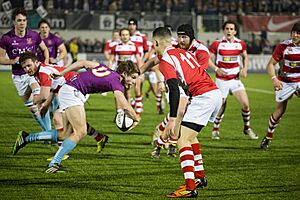
The competition between King's and University College London (UCL) is very strong. They are the two oldest universities in London. In the past, this rivalry involved their mascots. UCL's mascot was Phineas Maclino. King's later got its own mascot, Reggie the Lion, in 1923. Reggie often appeared in student parades.
In the past, there were even riots between students. Today, the rivalry is mostly seen in sports. The annual London Varsity series ends with a big rugby match.
Rivalry with the London School of Economics
On December 2, 2005, there was an incident between King's and the London School of Economics (LSE). LSE students caused about £32,000 of damage to King's English department. The LSE Students' Union later apologized. They also promised to pay for the damage.
Student Housing
Halls of Residence
King's has 13 student housing buildings (halls of residence) in London. First-year undergraduate students and international postgraduate students are guaranteed a place. Some halls are near Guy's Campus. Others are near St Thomas' Campus or Waterloo Campus. Champion Hill Residence is close to Denmark Hill Campus.
Some residences are run by other companies. These include Urbanest Tower Bridge and Angel Lane.
University of London Halls
King's students can also stay in halls run by the University of London. King's has the most spaces in these halls. There are eight intercollegiate halls. Most are near Russell Square in Bloomsbury. Students can also apply to live in International Students House.
Famous People from King's
Famous Former Students
Many famous scientists studied at King's. These include Nobel laureates Peter Higgs (Physics), Sir Michael Houghton (Medicine), and Michael Levitt (Chemistry). Others include Sir Francis Galton, a pioneer of eugenics. Raymond Gosling took a key photo that helped discover DNA's structure. Scientists from King's also contributed to the discovery of Hepatitis C.
Famous writers and poets include W. S. Gilbert, Thomas Hardy, and Virginia Woolf. Also, Sir Arthur C. Clarke and Sir Michael Morpurgo. Anita Brookner won the Booker Prize.
In religion, notable alumni include Nobel Peace Prize winner Archbishop Desmond Tutu. Also, former Archbishop of Canterbury Lord Carey. And former Chief Rabbi Lord Sacks.
In British politics, two Speakers of the House of Commons studied at King's. Also, former Foreign Secretary David Owen. Many members of the current House of Commons and House of Lords are King's graduates.
In the arts, alumni include impressionist Rory Bremner. Queen bassist John Deacon also studied here. Oscar winners Greer Garson and Edmund Gwenn are alumni. Grammy winners Boris Karloff and Sir John Eliot Gardiner also attended.
In law, King's alumni include the Chief Prosecutor of the International Criminal Court. Also, judges of the International Court of Justice.
In the military, alumni include high-ranking officers. These include Chief of the Defence Staff Sir Tony Radakin. Two people from King's won the Victoria Cross.
Other notable alumni include Walter Bentley, founder of Bentley Motors. Also, Olympic gold medalists Dame Katherine Grainger and Paul Bennett.
-
Polymath Sir Francis Galton (Medicine, 1839).
-
Dramatist Sir W. S. Gilbert of Gilbert and Sullivan (BA, 1856).
-
Science fiction writer Sir Arthur C. Clarke (BSc, 1948).
-
Queen bassist John Deacon (BSc, 1971).
-
Writer and philosopher Alain de Botton (MPhil, 1992).
-
24th Chief of the Defence Staff Tony Radakin (MA, 2000).
Nobel Prize Winners
There are 14 Nobel Prize winners connected to King's College London. The most recent are Sir Michael Houghton (2020 Nobel Prize in Medicine) and Sir Roger Penrose (2020 Nobel Prize in Physics).
Famous Academics and Staff
Many famous academics have taught at King's. These include Sir Charles Lyell (geologist). Also, Sir Charles Wheatstone (inventor of the Wheatstone bridge). James Clerk Maxwell (physicist) and Joseph Lister (pioneer of antiseptic surgery) also worked here.
Maurice Wilkins and Rosalind Franklin made key contributions to the discovery of DNA's structure. Sir Roger Penrose (physicist) and Mario Vargas Llosa (writer) are also notable.
Heads of Countries and International Groups

King's has educated many foreign leaders. These include two former Presidents of Cyprus. Also, Prime Ministers of Jordan, Iraq, and Grenada. The President of the Czech Republic, Petr Pavel, is an alumnus.
Many ministers and vice presidents also studied at King's. These include Deputy Prime Ministers of Canada and Singapore. Foreign Ministers of Albania, Japan, and Pakistan are also alumni. Michael Collins, who led the Irish Provisional Government, also attended King's.
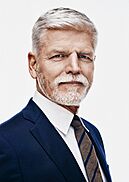
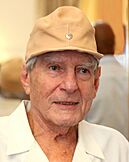
| State/Government | Individual | Office | Reference |
|---|---|---|---|
| Sir Lynden Pindling | Prime Minister (1969–1992) Premier (1967–1969) |
||
| Augustus Jaspert | Governor (2017–2021) | ||
| Tassos Papadopoulos | President (2003–2008) | ||
| Glafcos Clerides | President (1993–2003) | ||
| John Harding, 1st Baron Harding of Petherton | Governor (1955–1957) | ||
| Petr Pavel | President of the Czech Republic (2023–) | ||
| Nigel Phillips | Governor (2017–) | ||
| William Hare, 5th Earl of Listowel | Governor-General (1957–1960) | ||
| Ed Davis | Governor (2016–2020) | ||
| Maurice Bishop | President (1979–1983) | ||
| Abd al-Rahman al-Bazzaz | Prime Minister (1965–1966) | ||
| Michael Collins | Chairman of the Irish Provisional Government (1922) | ||
| Marouf al-Bakhit | Prime Minister (2005–2007; 2011) | ||
| Natalia Gherman | Acting Prime Minister (2015) | ||
| Sir Lee Moore | Prime Minister (1979–1980) | ||
| Sir Sydney Gun-Munro | Governor (1976–1979) Governor-General (1979–1985) |
||
| France-Albert René | Prime Minister (1976–1977) President (1977–2004) |
||
| Martin Bourke | Governor (1993–1996) | ||
| John Freeman | Governor (2016–2019) | ||
| Godfrey Binaisa | President (1979–1981) |
Images for kids
See also
 In Spanish: King's College de Londres para niños
In Spanish: King's College de Londres para niños



